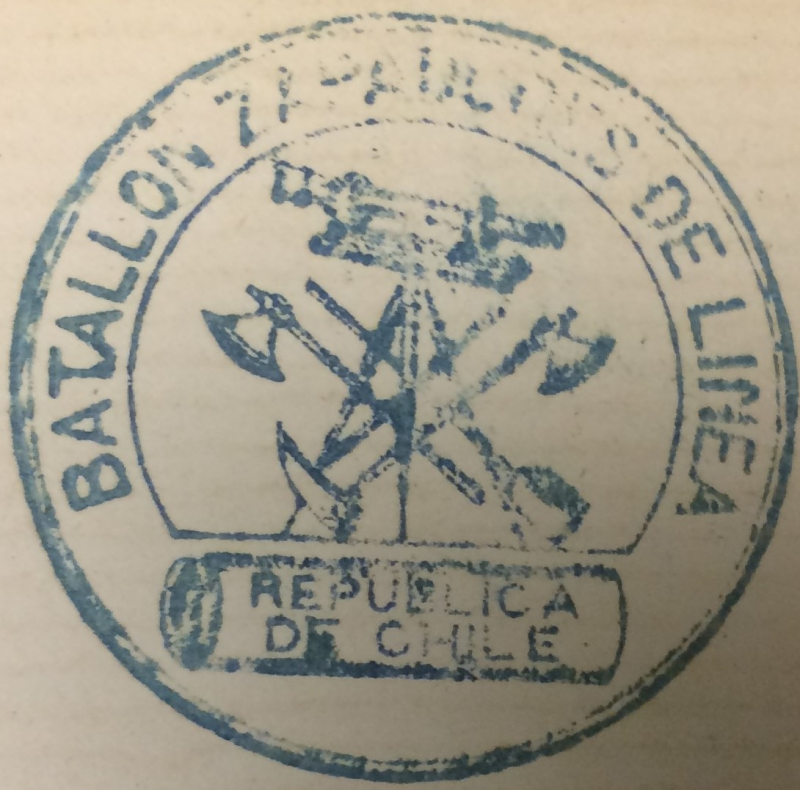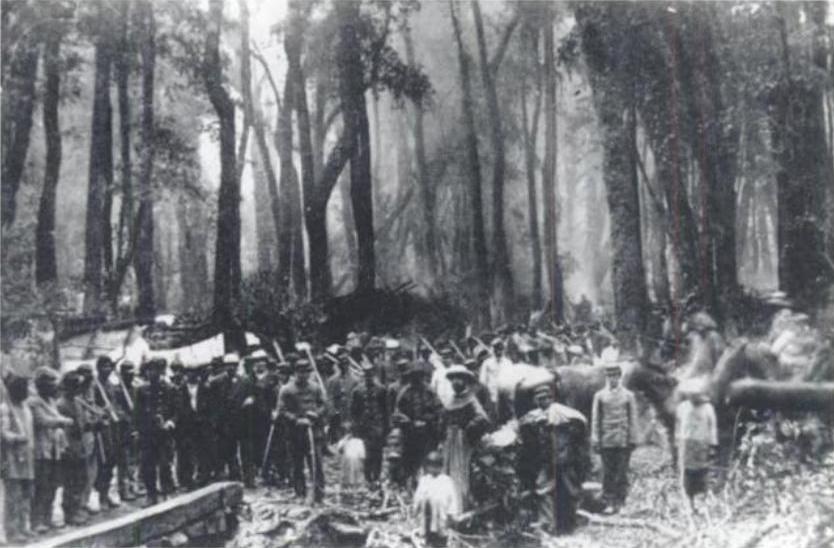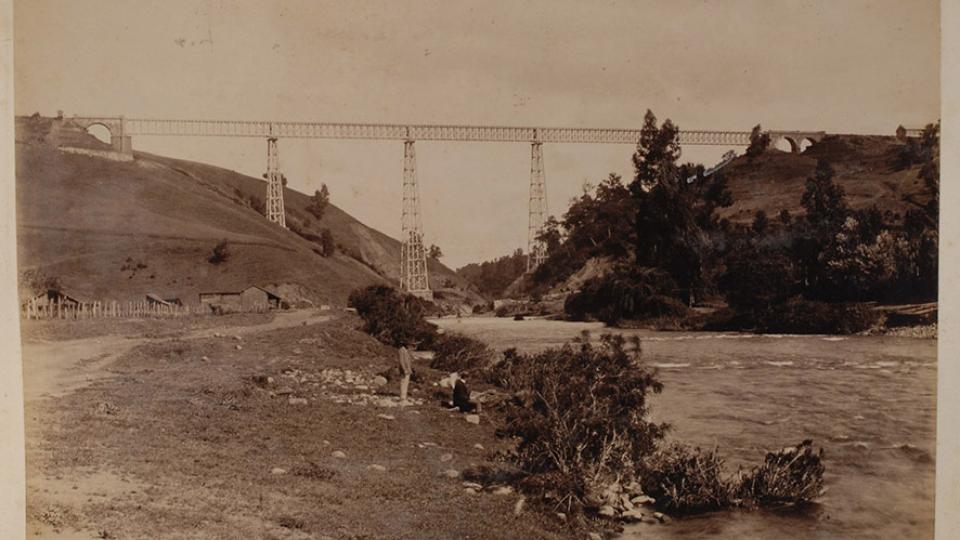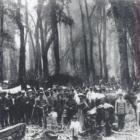
Engineer battalion water print, 1879.
Engineer battalion water print, 1879.
Courtesy of the Chilean Army Archives, Santiago.
 This work is licensed under a Creative Commons Public Domain Mark 1.0 License.
This work is licensed under a Creative Commons Public Domain Mark 1.0 License.
In the second half of the nineteenth century, Chile expanded its territory for political and economic reasons. This was the case of the Araucanía region, which was incorporated via a military campaign (1859–1884). The government wanted its fertile soils for agriculture and to exert sovereignty in a historically independent territory. Moreover, according to the Western thought of the epoch, the indigenous people of the region—the so-called Mapuche—ought to be civilized, since the prevailing thought of the day considered them a backward society.
However, records suggest that these “civilizing” efforts in the Araucanía were not only directed towards human beings, but also to the environment. This can be seen with the engineer battalion and its objective of transforming the landscape to make it more inhabitable for settlers, from 1877 to 1891―that is, from the year of its creation until its abandonment due to a Civil War in the north of Chile.

Mapuche family, 1890.
Mapuche family, 1890.
Photography by Juan de Dios Carvajal and Fernando Maximiliano Valck Wiegand, 1890.
Courtesy of Biblioteca Nacional de Chile, A33-0066.
Accessed via memoriachilena on 5 May 2020. Click here to view source.
 This work is licensed under a Creative Commons Public Domain Mark 1.0 License.
This work is licensed under a Creative Commons Public Domain Mark 1.0 License.
During the occupation of Araucanía, the Chilean government realized that the operation was not going to be easy due to the Mapuche resistance and the complex environment. For a long time the region was exempt from modern intervention. The Spanish failed in conquering the territory by the mid-sixteenth century, so indigenous people remained free in a region bordered by the Bio-Bio River in the north and the Toltén River in the south. This meant an absence of modern roads and a prevalence of dense mixed forests and wetlands throughout the landscape, which obstructed any foreign society interested in settling in the region. In 1870 the military commander in charge of the occupation campaign, Cornelio Saavedra, acknowledged that the forest was seriously complicating the plans of the government. It was important for the government to bring in Chilean and European settlers because they would exploit the land and thus spread civilization.
With such a reality it made sense to train army units not only to fight, but also to transform the landscape with constructions that would facilitate the settling of the region. Thus a decree in April 1877 stated that:
It is advisable for the development of agriculture, industry, and commerce and to the best service of the military operations in the Arauco provinces, Bío-Bío and the Colonization Territory, the organization of an engineer battalion to be in charge preferably of the opening, repairmen, and conservation of public roads, bridges, telegraphs, barracks, hospitals, fortifications, and other public works to be done.

Chilean troops during the occupation of the Araucanía. Note the forest in the background.
Chilean troops during the occupation of the Araucanía. Note the forest in the background.
Unknown photographer, n.d.
 This work is licensed under a Creative Commons Public Domain Mark 1.0 License.
This work is licensed under a Creative Commons Public Domain Mark 1.0 License.
Sources show that the aims of the battalion were in general accomplished from the day of its inception. The works completed by the battalion are too numerous to be written in this study, but as an example it can be said that they constructed sewers, irrigation canals, crop fields, drain pipes, bridges, barracks, roads, telegraphs, railroads, and even boats, among other constructions that focused on the northern part of the region.
Thus the military unit was seen as a sort of lever for the progress of the region and of the Mapuche. Perhaps the most direct evidence of this thought comes from the Lieutenant Ambrosio Letelier, who refers to the engineer regiment in December 1877. He wrote:
The Chilean soldier knows how to handle the rifle, just as well as handling the pry bar and the spade, the saw and the hammer, and he is as capable of civilizing the Indians by the example of his work, as dominating them by the armed force.
Adding later:
What we need more in the Araucania are good communication networks. Open the Cholchol road, repair the roads of Contulmo, Vega Larga, the Malleco line, and the Collipulli to Mulchén line. It should be done by the engineers before next winter, beginning soon. Then we will have done more for the conquest and domination of the Araucania, than what we would have done through many years of war and combat.

The Malleco Viaduct in 1890, with a length of 408 meters and a height of 102 meters.
The Malleco Viaduct in 1890, with a length of 408 meters and a height of 102 meters.
Photograph by Odber Heffer Bissett, 1890.
Courtesy of Cultura Digital UDP, A0006-000100.
Click here to view source.
 This work is licensed under a Creative Commons Attribution-NonCommercial-ShareAlike 4.0 International License.
This work is licensed under a Creative Commons Attribution-NonCommercial-ShareAlike 4.0 International License.
Letelier’s faith in the battalion was not wrong, because in the following years the unit would continue constructing devices that would help Chile consolidate its plan of civilization, surpassing natural obstacles if necessary. In 1889 the Belgium Gustav Verniory saw the military unit opening roads from Collipulli towards the Andes mountain range, and, in the same year, they helped to construct the Malleco viaduct, the tallest bridge at that time and thus a symbol of Chilean progress. At the launch of the viaduct the president of Chile—the liberal, José Manuel Balmaceda—said: “This wonderful monument will mark the future generations of the age when Chileans shook their traditional shyness and apathy and undertook the work of a new and solid enlargement.”

The Araucanía region at the moment of the Chilean occupation (1859–1884).
The Araucanía region at the moment of the Chilean occupation (1859–1884).
Map and graphics by Matías González Marilicán, 2020.
 This work is licensed under a Creative Commons Attribution 4.0 International License.
This work is licensed under a Creative Commons Attribution 4.0 International License.
In addition, the engineers eliminated forest and wetlands that interfered with communications. They felled trees on the hills of Lumaco in order to open roads, and they did the same on the Nahuelbuta mountain range between Purén and Contulmo. For Letelier, this was key for commerce. In 1877, Gregorio Urrutia, commander of the engineer battalion, trusted that his unit was capable of drying the Lumaco’s wetlands because they were the “reason for the constant humidity and, therefore, for epidemics that make the life of a town impossible.”
The case of the engineer battalion may help to understand not only the Chilean ruling class’s approach to the environment in the second half of the nineteenth century, but might also help in understanding how the current Chilean state relates with the Araucanía region and its indigenous population.
How to cite
González Marilicán, Matías. “Civilizing Nature with the Spade and the Rifle: The Engineer Battalion in the Araucanía Region, Chile (1877–1891).” Environment & Society Portal, Arcadia (Spring 2020), no. 21. Rachel Carson Center for Environment and Society. https://doi.org/10.5282/rcc/9043.
ISSN 2199-3408
Environment & Society Portal, Arcadia
 This work is licensed under a Creative Commons Attribution 4.0 International License.
This work is licensed under a Creative Commons Attribution 4.0 International License.
2020 Matías González Marilicán
This refers only to the text and does not include any image rights.
Please click on the images to view their individual rights status.
- Ejército de Chile. Historia del arma de ingenieros. Santiago de Chile: Ejército de Chile, 2011.
- Letelier, Ambrosio. “Informe sobre la Araucanía que pasa al señor ministro de guerra el comisionado especial, sargento mayor de artillería, don Ambrosio Letelier. 1877.” In Incorporación de La Araucanía. Relatos militares, 1822–1883, edited by Sergio Villalobos, 173–217. Santiago de Chile: Catalonia, 2013.
- Navarro, Leandro. Crónica militar de la conquista y pacificación de la Araucanía, desde el año 1859 hasta su completa incorporación al territorio nacional. Santiago de Chile: Pehuén editores, 2008.
- Saavedra, Cornelio. Documentos relativos a la ocupación de Arauco. Santiago: Biblioteca Fundamentos de la Construcción de Chile, 2009.
- Schouwen, Guillermo von. Ejército de Chile: Historia del Cuerpo Militar del Trabajo. Santiago de Chile: Ejército de Chile, 2003.
- Urrutia, Gregorio. Gregorio Urrutia to the Inspector Jeneral del Ejército, March 3, 1878. In Memoria de Guerra i Marina, presentada al Congreso Nacional de 1878, edited by M. García de la Huerta, no. 6. Santiago: Imprenta Nacional, 1878.
- Verniory, Gustav. Diez años en Araucanía, 1889–1899. Santiago de Chile: Pehuén editores, 2001.








